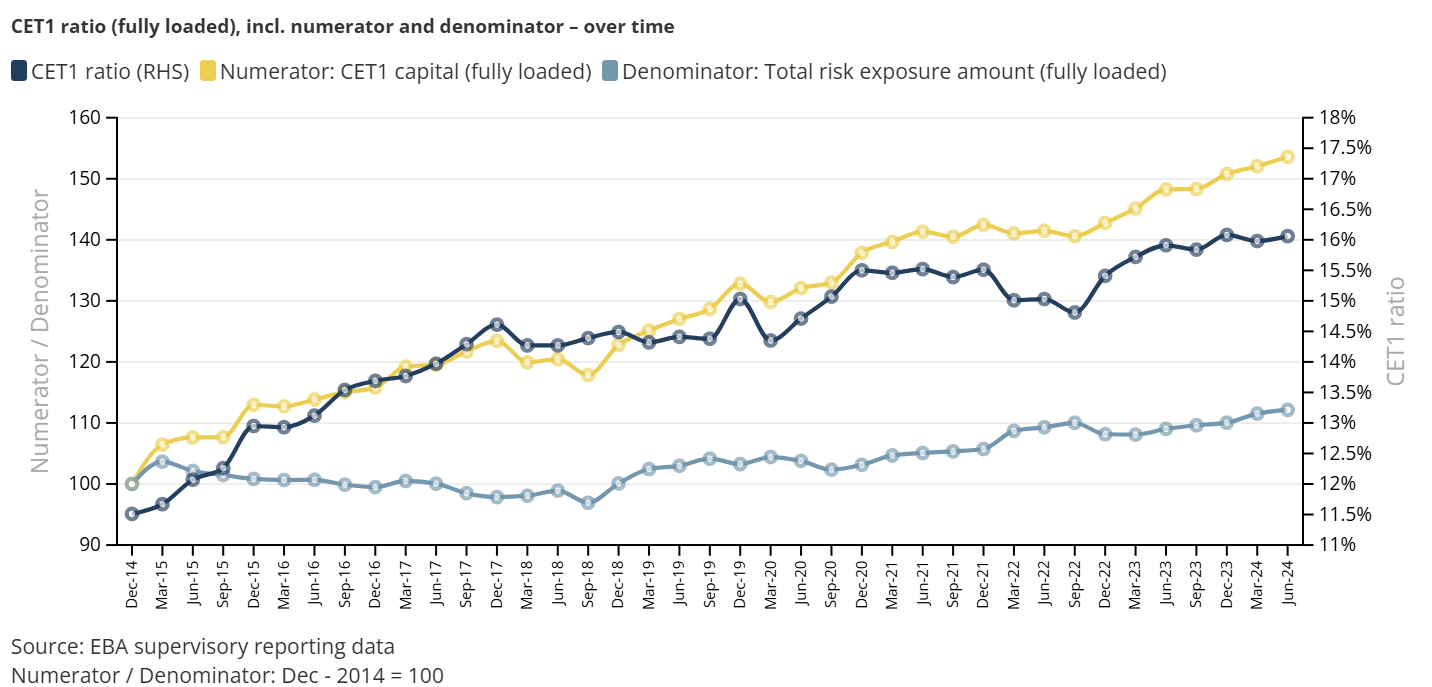The EBA clarifies the procedure for the classification of asset referenced tokens and e-money tokens as significant and the transfer of supervisory powers between the EBA and competent authorities
·Households’ financial assets up by €136 billion.
·Households’ liabilities unchanged; debt ratio down.
·Firms’ external financing down to €47 billion.
·Results take into account methodological changes to the financial accounts due to the Europe-wide benchmark revision.
Households’ financial assets increased further in the second quarter of 2024
In the second quarter of 2024, German households’ financial assets grew by €136 billion, closing the quarter at €8,815 billion.[1] This represents a new all-time high. Following an unusually strong rise in claims in the previous quarter (€87 billion), households increased their claims by €67 billion in the reporting quarter, which brought them to the average of the last two years. Unlike in previous quarters, there was no shift on balance from low-interest sight deposits to higher-interest time deposits. Instead, households increased their holdings of currency and sight deposits by €12 billion. This is the first growth seen in these categories since the fourth quarter of 2022. Transactions in favour of time deposits weakened to €39 billion, compared with €60 billion in the previous quarter.
Households also purchased debt securities as well as shares and other equity, each in the value of €5 billion. As in previous quarters, listed shares of domestic issuers were sold (-€1 billion) and shares of foreign issuers were purchased (+€2 billion). There was a marked increase in investment fund shares, with households acquiring €17 billion of these on balance.
In the second quarter of 2024, households recorded valuation gains totalling €69 billion. Investment fund shares accounted for valuation gains of €11 billion. The picture was mixed for shares and other equity – while listed shares of domestic corporations faced valuation losses of €15 billion, listed shares of foreign issuers achieved valuation gains of €10 billion. A further €42 billion is attributable to valuation gains on insurance and pension claims.[2]
Real total return on financial assets unchanged
The real total return – i.e. adjusted for inflation – on households’financial assets represents the actual return on financial assets for households based on the period-specific asset structure of financial assets. In the second quarter of 2024, the real total return stood at 1.5%, thus remaining virtually unchanged from the previous quarter. While shares in investment fund units, in particular, contributed positively to the real total return, the continued negative real return on currency and deposits had a dampening effect.
Households’ liabilities again unchanged
Households’ liabilities moved sideways in the second quarter of 2024, totalling €2,146 billion at the end of the quarter. As in the preceding quarters, the lack of growth in liabilities reflected the weak growth in loans for house purchase. The debt ratio fell by 0.5 percentage point to 50.4% due to the nominal increase in gross domestic product.[3]
According to the financial accounts, households’net financial assets increased in total by €136 billion to €6,669 billion in the second quarter of 2024. With the Distributional Wealth Accounts (DWA), the Bundesbank provides additional data on the distribution of households’ wealth. These data show that wealth inequality is fairly high in Germany. According to the DWA, the wealthiest 10% of households hold more than 70% of net wealth, while the less wealthy half of all households hold just under 1% of net wealth.[4]
External financing of non-financial corporations down
Non-financial corporations’ external financing declined by €4 billion to €47 billion in the last quarter. On balance, borrowing amounted to €26 billion, compared with €33 billion in the previous quarter. Issuance of shares and other equity remained stable at €13 billion.
In annual terms, based on four-quarter moving sums, non-financial corporations’external financing has declined since the third quarter of 2022.
At the end of the second quarter of 2024, non-financial corporations’ liabilities moved sideways, increasing very slightly by €3 billion to €11,424 billion[5]. Issued equity recorded losses in value (-€69 billion). Despite weaker external financing, loans rose to €3,676 billion. Here, there were positive valuation effects of €17 billion, which were largely attributable to exchange rate fluctuations in non-financial corporations’ external loans. Taken together, there was an increase in debt instruments relevant to the debt ratio, with a slight rise from 67.7% to 68.0%.[6]
The financial assets of non-financial corporations decreased by €45 billion, reaching €8,780 billion at the end of the quarter under review. Taken together, non-financial corporations’ net financial assets dropped to -€2,644 billion.
Owing to interim data revisions of the financial accounts and national accounts, the figures contained in this press release are not directly comparable with those shown in earlier press releases.
00001.As agreed at the European level, the benchmark revision of national accounts and balance of payments data took place in September 2024. This revision includes, on the one hand, fundamental methodological adjustments, but also corrections to individual business transactions. One of these adjustments, the consequences of which are visible in the figures in this press release, is the recalculation of unlisted shares and other equity (F.512 and F.519). The holdings and transactions (as well as valuation effects and other volume changes) of the sectors presented were revised in September 2024 for the years from 2016 onwards. The starting point for the new method is the annual individual financial statements according to the German Commercial Code (Handelsgesetzbuch or HGB). The issuance of unlisted shares and other equity is calculated on the basis of the equity position on the balance sheets of non-listed companies. A more detailed description of the method can be found in the new section entitled “Perspectives in financial accounts” on the financial accounts homepage.
00002.The methodology for calculating households’ technical provisions is based on the Solvency II reporting system, under which the discounted cash flow method is used to calculate/value these provisions: https://eur-lex.europa.eu/legal-content/EN/TXT/PDF/?uri=CELEX:02009L0138-20190113. The relevant interest rate structure for discounting technical provisions in Solvency II is determined by EIOPA on a monthly basis. At each valuation date, the provisions for all existing contracts must be valued at current interest rates. This form of market price valuation means that, under Solvency II, technical provisions are significantly influenced by the current interest rate environment. This means that individual quarters may exhibit stronger valuation effects.
00003.The debt ratio represents debt as a percentage of nominal gross domestic product (four-quarter moving sum).
00004.In the DWA, net wealth comprises the following types of assets and liabilities: deposits, debt securities, listed shares, investment fund shares, insurance claims (life insurance and private retirement provision), financial business wealth, and liabilities in the form of loans for house purchase and other debt. Net wealth is ultimately calculated as the difference between the total aforementioned assets and liabilities. For more information on the DWA, see also https://www.bundesbank.de/en/press/press-releases/bundesbank-releases-distributional-wealth-accounts-for-households-in-germany-921302
00005.See footnote 1.
00006.The debt ratio is calculated as the sum of loans, debt securities and pension provisions as a percentage of nominal gross domestic product (four-quarter moving sum). For loans, a partial consolidation is carried out by deducting intra-sector claims/liabilities.
The data on the financial accounts are available at
Financial accounts
The European Banking Authority (EBA) published today a Decision setting out the procedural aspects related to the significance assessment of asset-referenced tokens (ARTs) and e-money tokens (EMTs) and the transfer of supervisory responsibilities, including the establishment of supervisory colleges for significant ARTs (s-ARTs) and significant EMTs (s-EMTs).
The Markets in Crypto Assets Regulation (MiCAR) sets out a new supervisory regime for ART and EMT issuers, which includes significance assessments and reassessments of ARTs and EMTs by the EBA, transfer of supervisory responsibilities from national competent authorities to the EBA and the establishment of supervisory colleges for s-ARTs and s-EMTs.
In its Decision, the EBA details the following procedural aspects:
·it introduces a harmonised reporting calendar for national competent authorities and clarifies the respective reference periods and remittance dates.
·it clarifies the reporting obligations for issuers of s-ARTs and s-EMTs and the reporting of data relevant for the establishment of the supervisory colleges.
·it sets out the procedural arrangements and timeline to be followed for the consultation procedures with related parties when the EBA is to notify its draft and final decisions on significance assessment to the home NCA of the issuer, the issuer, the ECB and the national central bank, where relevant.
·it establishes the procedural steps and information required in this respect to support a smooth transition of supervisory competences between the EBA and national competent authorities for issuers of s-ARTs and issuers of s-EMTs.
·it provides for different templates to facilitate the implementation of the procedure, including a template for national competent authorities’ notification of voluntary classification requests from issuers of ART and EMT and a template for the issuer, the competent authority of the issuer’s home Member State, the ECB and relevant central bank to provide observations and comments in writing to the EBA’s draft decision to classify or to no longer classify an ART or EMT as significant.
Legal basis and background
The EBA Decision EBA/DC/558 was adopted on the basis of Articles 35 and 44 of Regulation (EU) No 1093/2010 (EBA Regulation), and Articles 43, 44, 56, 57, 117, 119 of Regulation (EU) 2023/1114 (MiCAR).
The EBA is responsible for carrying out assessments of ARTs and EMTs in order to identify if they meet the criteria for significance as set out in MiCAR. When classifying an ART or EMT as ‘significant’, the EBA is responsible for carrying out relevant supervisory tasks under MiCAR, including establishing, managing and chairing supervisory colleges.
The EBA is responsible for conducting direct supervision of issuers of s-ARTs, while s-EMTs (where issued by electronic money institutions) are subject to ‘dual supervision’ by the EBA and the respective home NCA. The EBA will exercise its supervisory powers in close cooperation with any other competent authorities responsible for supervising the respective issuers (in cases where the issuer also carries out other financial services activities). As part of its supervisory activities, the EBA may request information from issuers, conduct investigations, carry out on-site inspections, take supervisory measures and impose fines.
The EBA is continuously and actively engaging with national competent authorities to ensure it can carry out effectively its supervision mandate under MiCAR.
Documents
Decision on procedure for significance assessment MiCAR
(526.08 KB - PDF)
Annex 4 reporting for issuers of ARTs and EMTs - templates
(19.17 KB - Excel Spreadsheet)
·






















































First, please LoginComment After ~